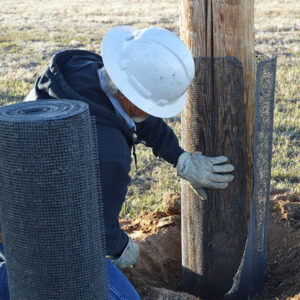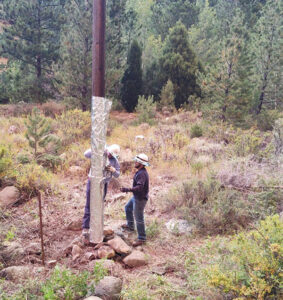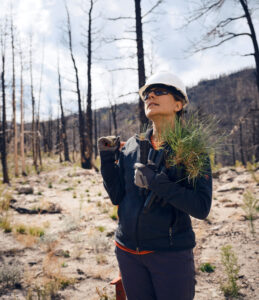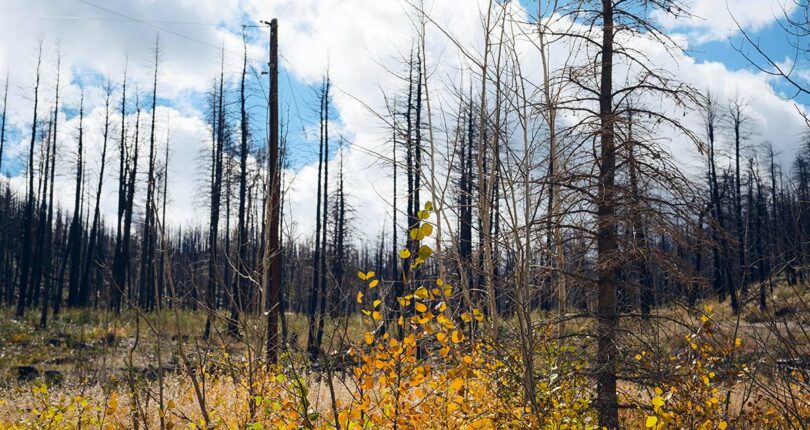How one local co-op takes care of its members before, during, and after a blaze
Fire is a natural part of healthy ecosystems across Colorado, but an increase in frequency, duration, and severity over recent years has scoured the state with major wildfires.

PVREA Lead Lineman Mike Lindenthal installs a fire retardant net barrier on a power pole.
The threat of fire is significantly higher in the wildland-urban interface where homes and businesses intermingle with undeveloped landscapes. When a wildfire hits these areas, the loss of life, destruction of property, and threat to water quality can be catastrophic.
Rural electric cooperatives provide service to the vast majority of these highrisk areas in Colorado. And according to one co-op, the task of wildfire prevention is a true labor of love.
“Because we’re a local co-op, we’re deeply rooted in the communities we serve,” Jeff Wadsworth, President and CEO at Poudre Valley REA says. “These are our friends, our neighbors, our family that we’re trying to protect.”
PVREA provides service to nearly 55,000 homes and businesses in northern Colorado. Recent wildfires in its service territory include the High Park Fire in 2012 that destroyed 259 homes, and the explosive Cameron Peak Fire in 2020 that consumed 470 buildings, 400 power poles, and 43 miles of power line.
“When a wildfire moves in, it changes everything,” Wadsworth says. “We’ve witnessed the impact on our members’ lives. That’s why we do everything in our power to keep people safe — before, during, and after a wildfire.”
We’re more than power lines and bucket trucks. We’re the people living, working, and raising families here. And we have a part to play in how our communities respond and renew.”
— Jeff Wadsworth, President and CEO at Poudre Valley REA
PREVENTION MEASURES
Like other electric co-ops across the state, PVREA has a formal Wildfire Mitigation Plan. “This is a living document,” explains John Bowerfind, Vice President of Engineering and Grid Advancement at PVREA. “We take what we’ve learned from industry leaders and past fires to adopt best practices moving forward. Our team routinely reviews and updates our plan to make it as effective and robust as possible.”

Aluminum-foil wraps temporarily help protect structures and equipment when wildfires threaten infrastructure.
A common theme throughout the plan is constant vigilance. PVREA deploys crews in the field to monitor and maintain equipment while additional crews manage vegetation.
In addition to boots on the ground, the co-op uses technology to remotely monitor 4,000 miles of line, especially in mountainous terrain. This includes drones, satellite imagery, and computer modeling to prioritize vegetation management and proactively address equipment concerns.
The co-op also maintains good working relationships with first responders, local governments, and land management agencies. They collaborate on everything from tree trimming to backup powergeneration solutions. Through local, regional, and national partnerships, PVREA brought cutting-edge microgrid technology to the isolated town of Red Feather Lakes. In the case of an extended outage, the microgrid can provide reliable backup power to essential emergency services, including the town’s volunteer fire department.
PVREA members play an important role in fire prevention, too. “We encourage our members to stay vigilant regarding electrical safety, work with us on vegetation management, and report any problems — large or small,” Bowerfind says. “Our ‘see something, say something’ philosophy promotes two-way communication. When members voice concerns, we respond quickly.”
ACTIONS TAKEN DURING A WILDFIRE
When the Cameron Peak Fire broke out, PVREA worked directly with fire incident command to assess threats to infrastructure in real time. Co-op crews covered poles in fire-retardant wrap and kept the power flowing for as long as it was safe to do so.
To protect firefighters and other first responders, PVREA remained on standby, ready to de-energize lines at a moment’s notice. “If there’s an energized line on the ground, it can start new fires,” Bowerfind explains, “and be deadly to fire crews.” Communication was key during the Cameron Peak Fire to keep emergency responders, partnering utilities, members, and news outlets informed. PVREA even arranged a daily time to call one member in the evacuation zone since he could only receive updates through his rotary phone.
POST-FIRE RECOVERY

A PVREA member helps plant seedlings during a PVREA sponsored volunteer event to aid in the recovery of the fire burn areas.
As the Cameron Peak Fire died down, PVREA sent crews into the charred landscape to visually assess the damage and safely restore services. Once PVREA restored power to its members, the co-op was eager to help its shaken communities recover.
“We’re more than power lines and bucket trucks,” Wadsworth says. “We’re the people living, working, and raising families here. And we have a part to play in how our communities respond and renew.”
To aid in the recovery of the watershed and flood mitigation efforts, PVREA partnered with the Coalition for the Poudre River Watershed, a local nonprofit on a mission to protect the health of its namesake. The co-op donated $50,000 to CPRW and invited PVREA members to join Coalition and co-op staff in planting more than 1,500 ponderosa pine trees in the burn scar. The seedlings will slow erosion and help restore the soil’s natural filtration process to protect the Poudre River — a source of drinking water for more than 300,000 people living on the Front Range.
“It feels good knowing the newly planted trees will help our community recover,” Wadsworth says, “and provide meaningful benefits for generations to come.”
Becky Jensen is a writer and podcast contributor who lives and works in a little cabin on a big river in Northern Colorado. She’s a former farm girl turned mountain mama and a proud member of Poudre Valley REA. You can find her at beckyjensenwrites.com.

